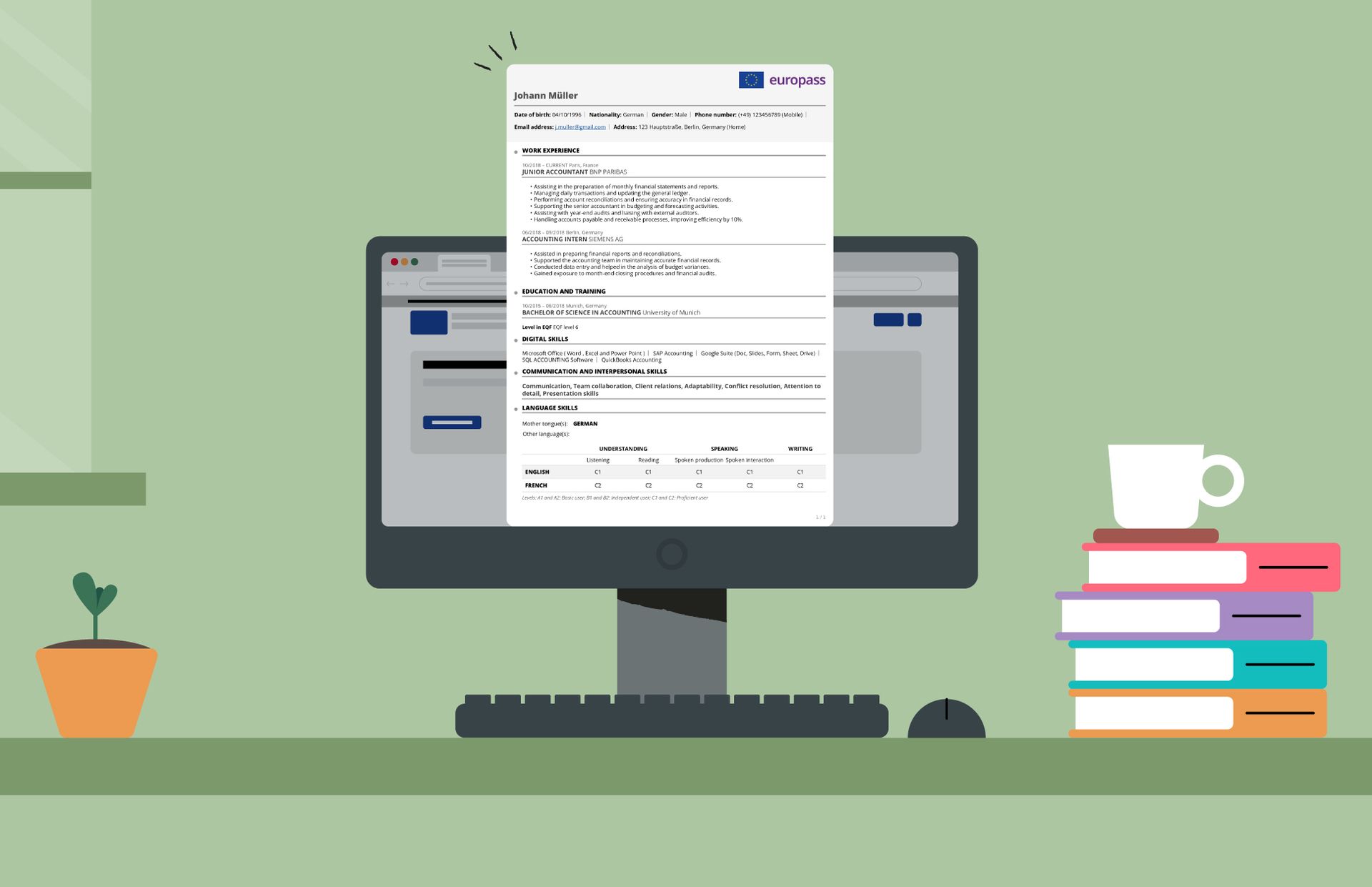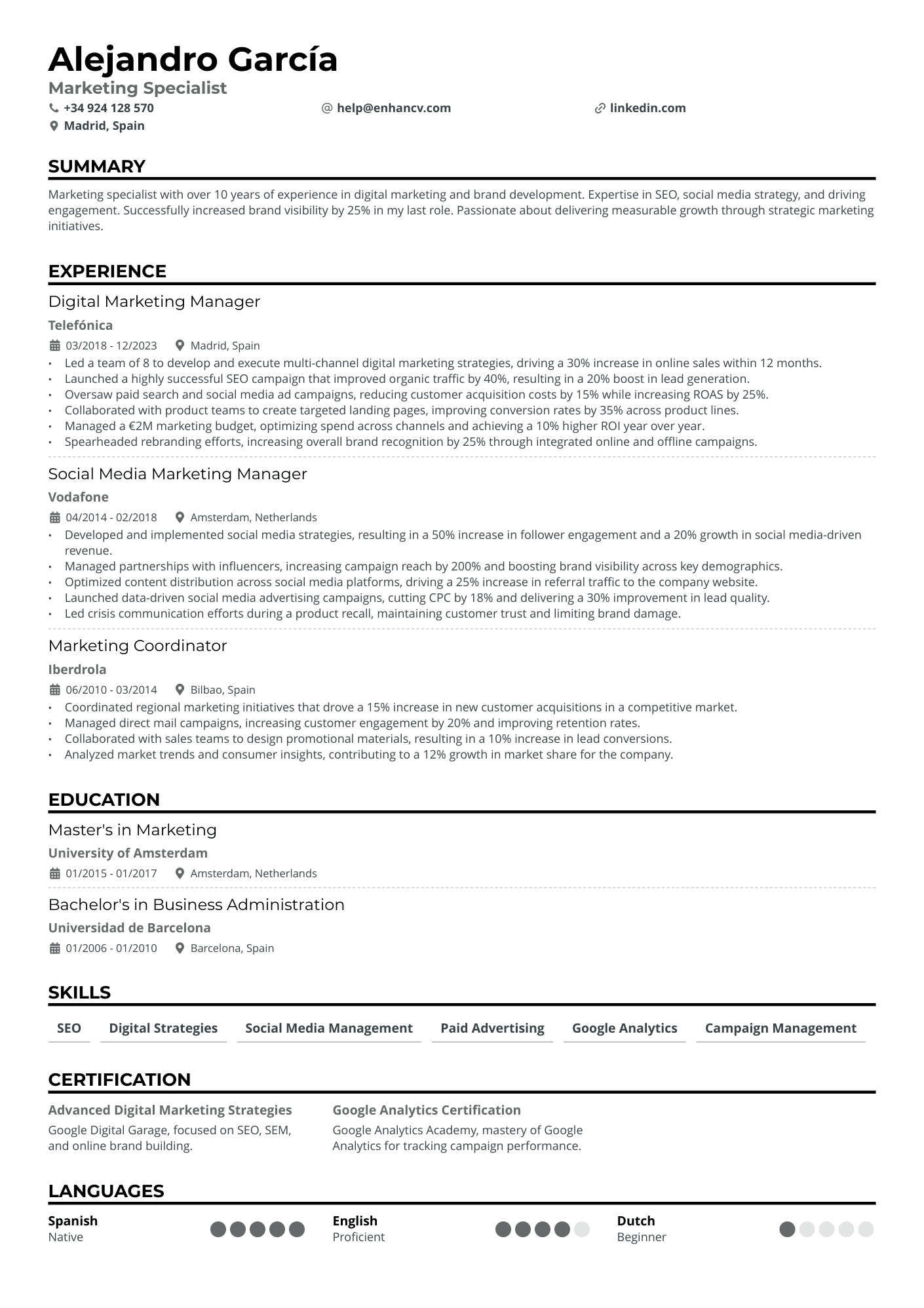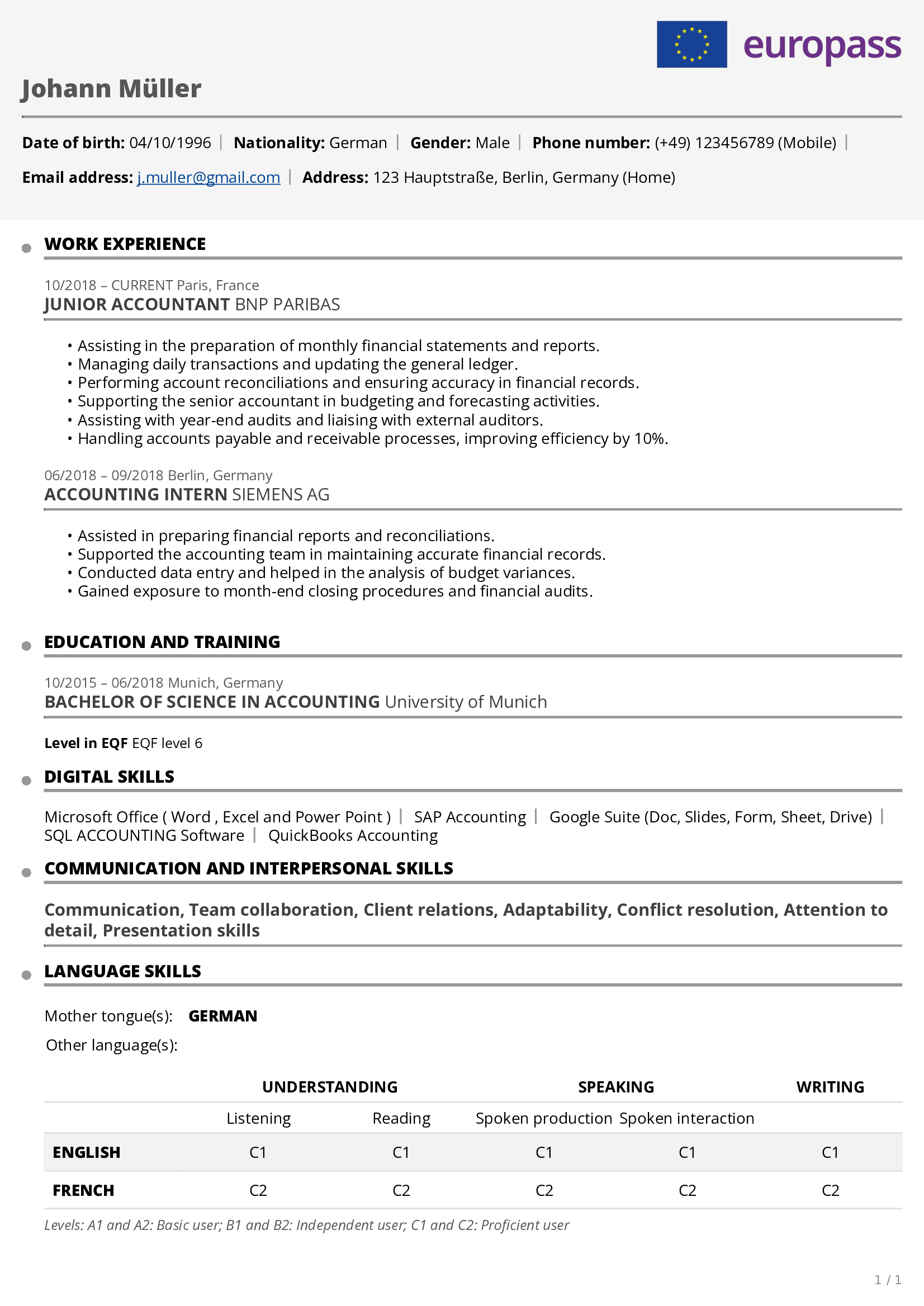The Europass CV is popular across Europe because of its straightforward format. But that’s also where it can fall short. Since so many people use it, your CV might look just like everyone else’s.
You don't want this, right?
Instead, you aim to grab the employer’s attention, especially when you’re applying for a job you’re really excited about. In 2025, the Europass CV format isn't your best option. It's outdated, lacks flexibility, and doesn't meet the needs of fast-evolving industries like tech or creative sectors for years.
Still, the Europass CV is a solid option for beginners, international applicants, students, and those required to use this specific format. As of 2024, companies in general don't specifically request a Europass CV unless they are operating in sectors that prioritize standardized formats, such as some educational institutions or government bodies in Europe.
Here’s a quick overview of what we’ll cover in this guide:
Key takeaways
- The Europass CV is popular in Europe due to its simple and standardized format.
- It may fail to stand out since many people use the same format, making it harder to differentiate yourself.
- The Europass CV is designed by the European Union to provide a consistent way of showing skills, education, and work experience.
- It's a deal for job seekers, students, migrants and professionals applying for positions across Europe.
- The Europass CV format includes sections like personal details, work history, and language skills.
- Alternatives to Europass CVs, like the Enhancv resume builder, offer more customization and modern design options.
Let's jump right in!
What is an Europass CV?
A Europass CV is a standard resume template created by the European Union. It helps people show their skills, education, and work experience in a clear way that’s easy for employers to understand. It includes sections for personal details, work history, education, language skills, and other abilities. The main aim of the Europass CV is to make it easier for employers to see what qualifications someone has, no matter where they’re applying from in Europe.
Want a quick way to get a professional-looking resume? Try using the template below. Just add your details and you’re good to go!
Who needs a Europass CV?
The Europass CV is a valuable tool for various groups looking to work or study in Europe. It helps people present their qualifications in a consistent way that’s recognized across the continent.
Here’s who can benefit the most from using a Europass CV:
- Job seekers aiming to work in different European countries
- Students and recent graduates applying for internships or entry-level jobs in Europe
- Professionals looking to advance their careers within Europe
- Individuals applying for European education or training programs
- Anyone seeking to enhance their chances of finding opportunities across Europe
Europass cv format and sample
You might come across both the Europass CV template and the Europass CV format online. Keep in mind they refer to the same thing.
The European CV format was designed by the European Commission and supported by Erasmus+. It’s now one of the most popular formats, and recruiters are very familiar with it.
Are you curious about what makes a Europass CV different? Here are the key features:
- Reverse-chronological order: This format puts your most recent work and education at the top, making it easy for recruiters to see your latest achievements. It’s structured to be straightforward and simple to scan.
- Focused and concise content: The Europass CV is designed to highlight only relevant information. Its structured format ensures there’s no clutter, helping recruiters focus on the most important aspects of your background.
- No personal statement or summary: Unlike other resumes, the Europass CV skips the personal introduction or professional summary. This might come off as less personal to some employers, as it jumps straight into your professional history.
Below you can see a Europass CV sample that provides a clear and detailed example of how to present your personal information, work experience, education and skills in a structured format.
Use this as a guide to create a compelling and professional CV that aligns with European standards.
How to create a europass cv?
Creating a Europass CV is a straightforward process that can be done online. Europass has provided a specialized website that allows you to build your standardized European CV for free.
The only thing you need to do before start using their free tool is create a profile, which should consist of your personal information, work experience, education and training, and personal skills.
This effort is definitely worth it, as that helps you create multiple Europass CVs which is a smart strategy when you're targeting different job opportunities. Tailoring each one to fit a specific role increases your chances of standing out and landing the job.
To get the best out of your Europass CV, you need to do 5 things:
- Present your experience clearly: Highlight examples of your skills and experiences matching the job you’re applying for and pay close attention to the details published in the job offer.
- Tailor your Europass CV: Make sure you update the ‘About Me’ section to underscore why you’re the best person for the job and focus on facts and main points that match the job you have in mind, rather than listing your full detailed history.
- Make your document readable: Ensure your Europass CV is easy to read, and use clear and simple language, and strong verbs (e.g., managed, developed, increased)
- Use reverse chronological order: Always list the most recent experience on the top, followed by previous ones. In case of long gaps in working or learning, include an explanation.
- Polish and proofread: Check for spelling and grammar mistakes, and provide a professional email address.
PRO TIP
Research the CV photo norms of the country you’re applying to. In Germany and France, including a photo is often expected, while in the UK and the Netherlands, it's generally best to leave it out.
Example of a europass cv
Seeing an example can make things a lot clearer. Here’s one to help you understand exactly what you need to do.
Europass cv writing tips
The first thing you need to do with your Europass CV is to grab the hiring manager’s attention with your words. Make sure you use strong action verbs and vivid adjectives to describe why you are the right person for the job through your qualifications, achievements, and skills.
Don’t forget to scan the job listing for any important keywords. You need to use those to catch the hiring manager’s eye and to pass through any Applicant Tracking Systems the company might be using for pre-selection.
Here are more helpful tips to consider while writing:
- Using numbers and percentages in your Europass CV highlights your skills and achievements, showing you're results-driven and effective.
- Tailor your Europass CV to each job description to show you fit the specific role and company.
- Focus on using unique, impactful language, avoiding clichés to stand out to hiring managers.
- Use detailed facts and numbers to quantify your achievements, making your qualifications stand out to hiring managers.
- Limit your Europass CV length to a one-pager by trimming unnecessary words and managing white space effectively. You can go for a two-pager if you think it’s better, but you need to make sure you have enough experience and skills for such a long document.
- Check for spelling, grammar errors, inconsistent punctuation, and unclear sentences. Consider asking friends or family to proofread.
Europass popularity
An average of 1.5 million Europass accounts are created annually, totaling 6.9 million accounts to date.
Differences between US and uk resume format & europass cvs
Let’s take a closer look at how resumes from the US and the United Kingdom compare to a Europass CV. While all these formats are designed to underscore your skills and qualifications, each one has its own distinct features tailored to its job market. Understanding these differences can help you choose the best format for your career goals, whether you’re aiming for opportunities in the US, UK, or across Europe.
This table outlines the key distinctions between these resume formats, giving you a clear understanding of how to structure your application to make an impact, no matter where you’re applying.
| Feature | UK Resume Format | US Resume Format | Europass CV Format |
|---|---|---|---|
| Length | 2 pages, concise and to the point | 1-2 pages, concise | Often 2+ pages, more detailed |
| Objective/Summary | May include a brief personal statement | Common to include a summary or objective statement | No objective statement, focuses on factual information |
| Personal information | Basic details (name, phone, email) | Minimal (name, phone, email) | Includes more details (name, phone, email, address, nationality) |
| Photo | Typically not included | Typically not included | May include a photo, depending on the country |
| Sections | Flexible (personal statement, skills, experience, education) | Flexible (summary, skills, experience, education) | Standardized (personal info, work experience, education, skills) |
| Skills section | Often concise, relevant skills highlighted | Brief, often bullet points | More detailed, including language skills and levels |
| Customization | Tailored to specific job applications | Often tailored to specific job applications | More standardized, less emphasis on customization |
| Design | Simple, professional layout | Can be creative and visually appealing | Standardized format with less emphasis on design |
| References | Common to include or state "Available upon request". | Often listed as "Available upon request". | Typically not included in the Europass format |
Europass alternative: use enhancv resume builder
The Europass CV format can be quite limiting and might not make your job search as effective as you'd like.
So, what's a better way to create a standout resume or CV?
Use Enhancv'sfree resume builder. It offers customizable templates that allow you to highlight your unique skills and experiences. With intuitive design options, you can create a professional and visually appealing resume that captures your personality. Whether you're applying for jobs in Europe or elsewhere, Enhancv provides the flexibility and creativity needed to make a lasting impression on employers.
If you already have a Europass CV and want to check its ATS compatibility, you can use Enhancv’s free resume checker to find out.
Here’s a quick table to show you how Enhancv offers more advantages than the Europass CV:
| Feature | Enhancv Resume Builder | Europass CV Builder |
|---|---|---|
| Templates | Over 15 customizable templates and thousands of design options | Only 4 templates |
| Customization | High customization with drag-and-drop features | Limited customization, fixed structure |
| Design | Modern, visually appealing designs | Basic, plain design |
| User interface | User-friendly, intuitive, with real-time tips | Simple, less interactive |
| ATS compatibility | Optimized for ATS, provides feedback on compatibility | Limited ATS optimization features |
| Accessibility | Cloud-based, accessible from any device | Web-based, requires login |
| Support for sections | Supports creative sections like "Life Philosophy", "My time", "Books", etc. | Standardized sections only |
| Integration with LinkedIn | Can pull data directly from LinkedIn | No integration |
| AI assistance | AI-powered suggestions and resume optimization | No AI support |
| Removable logo | Yes | No |
While we're still on the subject of advantages, let’s take a closer look at some of the pros and cons of the Europass CV.
Advantages and disadvantages of a europass cv
When deciding whether to use a Europass CV, it's important to weigh its pros and cons. While this format offers simplicity and international recognition, it may also lack the flexibility and creativity needed to stand out.
Pros
Despite the criticism, the Europass CV offers some notable advantages worth considering.
- Free to use and supports creating, storing, and sharing CVs in 29 different languages.
- Provides a matching cover letter, making the application process seamless.
- Recognized internationally by hiring managers, ensuring familiarity with its format and layout.
- Simplifies the application process by guiding you to include all necessary details such as work experience, volunteer work, education, and skills.
Cons
Now that we know the advantages of Europass CV, let’s take a look at why it’s so criticized.
- Limited in showing individuality and creativity.
- Not suitable for roles requiring a customized or visually appealing CV.
- Best for those with limited time or resources for a unique CV.
- Gapping white spaces that leave lots of space unused.
- Outdated designs that don't match current resume trends.
- A confusing and less user-friendly CV builder.
- Website bugs that can cause data loss or submission errors.
- May blend in with other applicants, reducing visibility to recruiters.
PRO TIP
European recruiters are accustomed to seeing this format, so it might be more challenging to make a strong impression. We advise you to avoid this format unless specifically requested.
The Europass CV is useful for its simplicity and international recognition, making it a practical choice for those seeking a quick and easy template. However, its standardized format limits personalization, which may reduce its impact in job markets that value creativity and individuality.
Who uses a europass cv?
The Europass CV is commonly used by individuals seeking job opportunities within Europe, including job seekers, students, and recent graduates looking for internships or entry-level positions.
It's also popular among professionals aiming to advance their careers in European countries and those applying for educational programs across Europe.
You can use this format in the following countries:
Countries that use Europass CV format
- Austria
- Belgium
- Bosnia and Herzegovina
- Bulgaria
- Croatia
- Cyprus
- Czechia
- Denmark
- Estonia
- Finland
- France
- Germany
- Greece
- Hungary
- Iceland
- Ireland
- Italy
- Latvia
- Lithuania
- Luxembourg
- Malta
- Montenegro
- Netherlands
- North Macedonia
- Norway
- Poland
- Portugal
- Romania
- Serbia
- Slovakia
- Slovenia
- Spain
- Sweden
- Switzerland
- Turkey
Frequently asked questions about Europass CV
How long should my Europass CV be?
Your Europass CV should ideally be 1-2 pages long, but it can extend to a maximum of 4 pages if you have extensive work experience or qualifications. Make sure to focus on relevant information to maintain clarity and readability.
In what formats can I download a Europass CV?
You can download the Europass CV in PDF format, which ensures that the layout and formatting remain consistent when viewed or printed. Additionally, you may have options to download it in Microsoft Word or OpenDocument formats, allowing for further editing if needed.
How to download a CV from Europass?
To download your CV from Europass, log in to your account, select the CV you want to download, and choose your preferred format.
Can I remove the Europass logo from my CV?
No, the Europass logo is embedded in the CV template, and it cannot be removed. The logo is part of the standardized format, which ensures that the document is recognized as a Europass CV by employers and educational institutions across Europe.
Conclusion
The Europass CV offers a straightforward and widely recognized format across Europe, making it a practical choice for those seeking jobs, internships, or educational opportunities within the continent. However, its standardized design can limit your ability to showcase individuality, which might be essential in more creative or competitive industries.
Make one that's truly you.






